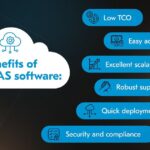In today’s digital world, choosing the right software is one of the most crucial decisions a business can make. With a plethora of Software-as-a-Service (SaaS) solutions available, finding the right fit can be challenging. Each business has its unique needs, goals, and processes, and what works for one might not work for another. This guide walks you through understanding SaaS, identifying your business requirements, evaluating potential solutions, and making the final selection. Let’s dive into how to choose the perfect SaaS solution that aligns with your business needs.

Introduction: Why Choosing the Right SaaS Solution Matters
Software-as-a-Service (SaaS) refers to cloud-based software applications that are hosted online and made available to customers on a subscription basis. SaaS has transformed how businesses operate by offering accessible, flexible, and scalable tools. However, not every SaaS product will match your specific requirements, and choosing the wrong one can lead to inefficiencies, wasted resources, and unmet goals. The right SaaS solution should not only address your immediate business needs but also have the potential to scale as your organization grows.
Understanding Your Business Needs
Before you start looking at SaaS options, it’s essential to understand what you need from the software. Take a closer look at the day-to-day processes within your business. Here are a few key aspects to evaluate:
a. Define Your Goals and Objectives
Begin by defining what you want to achieve. Are you looking to streamline communication, improve collaboration, enhance customer relationship management, or automate specific tasks? Clear goals will help narrow down your options and prevent getting swayed by unnecessary features.
b. Identify Pain Points
Think about the current issues you face with your existing tools or processes. Are there gaps in communication, slow workflows, or errors in data handling? Listing out these pain points will guide you toward a SaaS solution that addresses your primary concerns.
c. Consider the Future
Your business needs today might not be the same in a year. Find a SaaS solution that can grow with your business, whether it’s through additional modules, scalability, or user expansion.
Key Features to Look for in a SaaS Solution
Once you’ve identified your needs, it’s time to consider the key features that will best support your business operations. While each industry may have specific requirements, here are some general features to look out for in any SaaS tool:
a. User-Friendly Interface
A user-friendly interface is essential for seamless adoption by your team. A complex or poorly designed tool may slow down productivity rather than improve it. Look for solutions that offer intuitive navigation and clear, understandable design.
b. Integration Capabilities
Your SaaS solution should integrate smoothly with other tools you already use, such as CRM software, email marketing tools, or accounting platforms. This helps streamline workflows, reduce manual data entry, and minimize the risk of errors.
c. Data Security and Compliance
Data security is a top priority, especially if your SaaS solution will handle sensitive customer or business information. Check if the provider follows industry-standard security protocols and whether they comply with relevant regulations, like GDPR or HIPAA, depending on your business sector.
d. Mobile Access
With the increase in remote work, mobile access to SaaS platforms has become essential. Ensure that the solution you choose is compatible with mobile devices or has a dedicated app, so your team can stay productive from anywhere.
e. Customization Options
Each business is unique, so it’s helpful if your SaaS tool allows for customization. From branding and user permissions to personalized dashboards, the ability to tailor the solution to meet your specific needs adds value.

Budget Considerations and Value for Money
Budget plays a significant role in deciding which SaaS solution to choose. Remember, while it’s tempting to go for the cheapest option, the solution must provide real value. Consider both the initial and long-term costs of the software.
a. Subscription Models and Pricing Tiers
Most SaaS providers offer multiple pricing tiers based on the number of users, features, or data storage capacity. Evaluate each tier to determine which one offers the best value for your money. Ensure the pricing aligns with your business’s cash flow and growth plans.
b. Hidden Costs
Some SaaS solutions have hidden costs, such as additional fees for support, training, data migration, or third-party integrations. Be sure to ask the vendor about any potential extra charges that may arise.
c. Free Trials and Demos
Take advantage of free trials and demos. They offer hands-on experience with the tool, helping you better understand its functionality, ease of use, and whether it suits your needs.
Evaluating SaaS Solution to Providers and Support
Selecting the right software is not just about the tool itself, but also about the company behind it. You want to choose a reliable SaaS provider with strong customer support and a good reputation in the market.
a. Research Customer Reviews
Online reviews on platforms like G2, Capterra, or Trustpilot can provide insights into the experiences of other users. Look for consistent complaints or praises, as these can reveal the tool’s strengths and weaknesses.
b. Assess Customer Support Quality
Good customer support is vital, especially when facing technical issues or during the onboarding process. Check if the vendor provides multiple support channels (phone, email, chat) and whether they offer round-the-clock support.
c. Vendor Stability and Longevity
A stable SaaS provider is less likely to experience significant downtime or service disruptions. Research the vendor’s background, client base, and how long they’ve been in business. This can provide reassurance that they’ll be around in the long term to support your needs.
Ensuring Data Migration and Onboarding
Implementing a new SaaS solution requires careful planning, especially during the data migration and onboarding phase. Poor migration can lead to data loss or inaccuracies, while inadequate onboarding may result in low adoption rates among your team.
a. Data Migration Services
Data migration is often a critical part of SaaS adoption. Check if the provider offers assistance or guidance with data migration to avoid potential issues. Some may provide automated migration tools, while others might require a more manual approach.
b. Training and Onboarding Resources
Successful onboarding is key to ensuring your team can maximize the tool’s benefits. Look for vendors that offer training materials, such as video tutorials, webinars, or live sessions, to help your team get comfortable with the new software.
Measuring Performance and Analyzing ROI
Once the SaaS solution is in place, it’s crucial to monitor its effectiveness to ensure it’s delivering the expected results. Measuring performance and return on investment (ROI) helps determine whether the tool remains a valuable asset to your business over time.
a. Key Performance Indicators (KPIs)
Define the KPIs that align with your goals, such as improved response times, increased customer satisfaction, or reduced task completion times. These indicators can help track the software’s impact on your business.
b. Gathering Team Feedback
Your team’s feedback is essential in evaluating the SaaS solution’s performance. Are they finding it easy to use? Has it made their tasks more efficient? Regular feedback helps address any issues early on and ensures continued satisfaction with the software.
Make Your Decision and Prepare for Implementation
Once you’ve evaluated all aspects, choose the SaaS solution that best fits your business needs. Ensure a smooth implementation process by setting up a project timeline, defining responsibilities, and training employees.
Steps for a Successful Implementation
- Set a Timeline: Define clear phases for testing, training, and full implementation.
- Assign a Point Person: Appoint someone responsible for managing the rollout and serving as a contact point for any issues.
- Monitor and Review: Gather feedback from users to ensure the software is meeting expectations and make adjustments as necessary.
Conclusion: Making an Informed Decision
Choosing the right SaaS solution can significantly impact your business’s productivity and overall success. By understanding your business needs, setting a budget, evaluating features, and ensuring good support and onboarding processes, you can find a SaaS tool that truly meets your requirements. Remember, the decision doesn’t end at the point of purchase. Continuously assess the tool’s performance and gather feedback to ensure it stays aligned with your evolving business needs. With a thoughtful approach, your chosen SaaS solution can become a powerful asset that drives your business forward.




